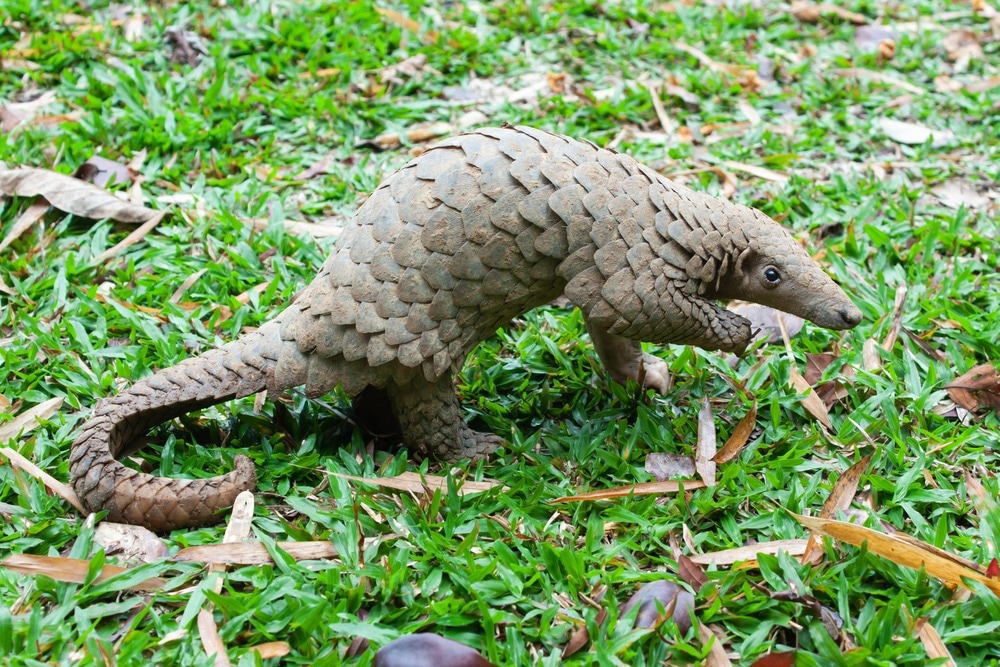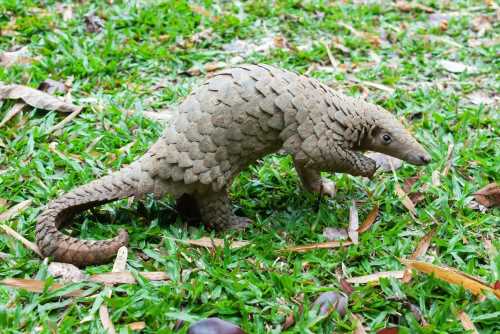In a recent study published in Cell, researchers reported the circulation of a novel Middle East respiratory syndrome (MERS)-like coronavirus (CoV) among Malayan pangolins, Manis javanica HKU4-associated CoV (MjHKU4r-CoV).

Background
The zoonotic origin and transmission of CoVs causing outbreaks in humans, such as MERS, severe acute respiratory syndrome (SARS), and coronavirus disease 2019 (COVID-19), is not well-characterized. Bats harbor several coronaviruses from the Merbecovirus and Sarbecovirus subgenus, and MERS-CoV, SARS-CoV-1, and -2 have reportedly originated from bats.
However, bat CoVs usually need further adaptations before infecting and replicating in host cells, indicating the need for intermediate animal hosts. Continued surveillance efforts and research are required to deepen the understanding of pangolins as susceptible hosts or reservoirs of bat-associated CoVs and improve preparedness for probable MERS-like CoV emergence in pangolins.
About the study
In the present study, researchers explored pangolins as reservoirs or susceptible host species for zoonotic bat CoV transmission.
Anal region swab specimens (n=86) of Malayan pangolins, smuggled illegally from the southeastern regions of Asia into China, were subjected to pan-CoV quantitative and real-time polymerase chain reaction (PCR) with the ribonucleic acid (RNA)-dependent RNA polymerase (RdRp) gene as a target.
Subsequently, next-generation sequencing, metagenomics analysis, Sanger sequencing, rapid amplification of complementary deoxyribonucleic acid ends (RACE), phylogenetic analysis, Western blot, and recombinant analyses were performed. Biolayer interferometry experiments, interferon-I (IFN-I) production and signaling luciferase reporter assays, antiviral assays, and fluorescence reduction viral neutralization assays were performed.
To investigate MjHKU4r-CoV prevalence among pangolins, MjHKU4-CoV-1 nucleocapsid (NP) protein-based luciferase immunoprecipitation system (LIPS) assays were performed. Further, viral particles were examined by transmission electron microscopy, and immunofluorescence analysis was performed using human colorectal adenocarcinoma cells (Caco-2 cells) for NP staining.
The team investigated whether MjHKU4r-CoV-1 used the human dipeptidyl peptidase-4 (hDPP4) for cell entry by inoculating human hepatoma (Huh-7) cell lines with and without DPP4 with MjHKU4r-CoV-1. The team assessed whether point mutations in the estimated furin cleavage region would reduce proteolytic spike (S) protein cleavage and viral infection.
In addition, the team investigated if the protease cleavage was specific to furin and whether MjHKU4r-CoV-1 could infect bats and humans. The probable host range of the virus was determined. MjHKU4r-CoV-1 infection was assessed in several human cell lines, organs, and ex vivo organoids. Additionally, in vivo analyses were performed using hDPP4-transgenic mice challenged intranasally with MjHKU4r-CoV-1 to evaluate MjHKU4r-CoV-1 pathogenicity. Virally coded interferon antagonists, and the therapeutic efficacy of known treatment agents against MjHKU4r-CoV-1, were determined.
Results
Antibodies eBook

A novel MERS-like coronavirus (Merbecovirus) MjHKU4r-CoV, phylogenetically associated with bat HKU4- CoV was identified among Malayan pangolins. The isolated MjHKU4r-CoV-1 virus Caco-2 cells used hDPP4 and cellular proteases for cell entry, and the binding was enhanced by a furin cleavage site (most likely RQQR) absent in known bat HKU4r-CoVs. MjHKU4r-CoV-1 had a wider host range, broadened by furin, compared to HKU4-CoV of bats, and was infectious and pathogenic among the transgenic murine animals and the intestinal and respiratory organoids of humans.
Out of 86 animals, four were seropositive by pan-CoV PCR, and seven serum samples showed MjHKU4r-CoV seropositivity in the LIPS assays (11% and 13%). Four almost identical genome sequences were obtained from samples of Manis javanica HKU4-associated CoV 1 to 4 (MjHKU4r-CoV-1–4). MjHKU4r-CoV-1 shared 87% and 68% genetic identity with HKU4-CoV and MERS-CoV, respectively. MjHKU4r-CoV-1 showed the greatest nucleotide similarity with HKU4-CoV of bats.
No recombination events were observed in the genomic sequences of MjHKU4r-CoV-1. MjHKU4r-CoV-1 was found to belong to the Tylonycteris bat CoV HKU4 species of Merbecovirus subgenus. Viral particles showed the usual CoV morphology and a 100.0 nm diameter. MjHKU4r-CoV-1 infection was considerably dampened in the human hepatoma cells pre-treated with E64D, a cysteine-class protease inhibitor. The trypsin enzyme was not required for viral infection, indicating that MjHKU4r-CoV-1 adapted fully to proteolytic-type cleavage among human cells.
The team observed proteolytic cleavage for MERS-CoV and wild-type MjHKU4r-CoV-1 spike proteins but not for the mutated proteins of HKU4-CoV and MjHKU4r-CoV-1. A host protease cleaved the MjHKU4r-CoV-1 spike protein during synthesis, and cleavage was critical for cell entry. Infection with MjHKU4r-CoV-1 was mediated by DPP4 protein orthologs from goats, pigs, rabbits, cats, sheep, macaques, camels, cattle, and marmosets, but not from horses, ferrets, hamsters, rats, mice, and dogs. MjHKU4r-CoV-1 effectively proliferated in human A549, Caco-2, Calu-3, Huh-7, and human embryonic kidney 293 (HEK293) cells, indicative of a broad viral tropism.
MjHKU4r-CoV-1 infection resulted in delayed interferon responses in the Caco-2 cell lines, indicating that the host interferon (IFN) response was evaded by the virus. Spike, membrane (M), open reading frame (ORF)-3, and 04a significantly inhibited the activation of the IFN-β promotor, whereas M, NP, ORF-3,-4a, and -4b, and -8b significantly inhibited the promoter activity of type I interferon-stimulated response element (ISRE). Remdesivir, EIDD-2801, and C376 showed anti-MjHKU4r-CoV-1 effects, suppressing infection by MERS-CoV and MjHKU4r-CoV-1 to a similar extent.
Conclusion
Overall, the study findings highlighted a novel circulating MERS-like CoV among Malayan pangolin animals and showed pangolins as reservoirs of coronaviruses likely to affect humans.
- Chen, J. et al. (2023) "A bat MERS-like coronavirus circulates in pangolins and utilizes human DPP4 and host proteases for cell entry", Cell, 186(4), pp. 850-863.e16. doi: 10.1016/j.cell.2023.01.019. https://www.cell.com/cell/fulltext/S0092-8674(23)00049-1
Posted in: Medical Science News | Medical Research News | Disease/Infection News
Tags: Adenocarcinoma, Cell, Colorectal, Coronavirus, Coronavirus Disease COVID-19, covid-19, Cysteine, Efficacy, Electron, Electron Microscopy, Enzyme, Ex Vivo, Fluorescence, Gene, Genetic, Genome, Genomic, Immunoprecipitation, in vivo, Interferon, Kidney, Luciferase, Membrane, MERS-CoV, Metagenomics, Microscopy, Morphology, Nucleotide, Organoids, Polymerase, Polymerase Chain Reaction, Promoter, Protein, Remdesivir, Research, Respiratory, Ribonucleic Acid, RNA, Sanger sequencing, SARS, Severe Acute Respiratory, Severe Acute Respiratory Syndrome, Spike Protein, Syndrome, Transgenic, Virus, Western Blot

Written by
Pooja Toshniwal Paharia
Dr. based clinical-radiological diagnosis and management of oral lesions and conditions and associated maxillofacial disorders.
Source: Read Full Article
